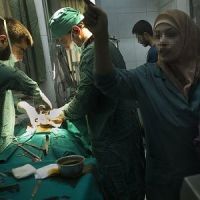A mandate in 2009 that critically injured U.S. servicemen should receive definitive care within the so-called "golden hour" has improved survival rate of combat casualties in Afghanistan, according to a study published in JAMA Surgery.
In 2009, Secretary of Defense Robert M. Gates mandated a standard of 60 minutes or less, from call to arrival at the treatment facility, for prehospital helicopter transport of U.S. military casualties with critical injuries, cutting in half the previous goal of two hours.
Russ S. Kotwal, MD, MPH, of the United States Army Institute of Surgical Research, Joint Base San Antonio-Ft. Sam Houston, and colleagues compared morbidity and mortality outcomes for casualties before vs. after the mandate and for those who underwent prehospital helicopter transport in 60 minutes or less vs. more than 60 minutes. The analysis included battlefield data for 21,089 U.S. military casualties that occurred during the Afghanistan conflict from September 2001 to March 2014.
For the total casualty population, the percentage killed in action ([KIA] 16 percent [386 of 2,411] vs. 9.9 percent [964 of 9,755]) and the case fatality rate ([CFR] 13.7 (469 of 3,429] vs. 7.6 (1,344 of 17,660) were higher before vs. after the mandate; the percentage died of wounds ([DOW] 4.1 percent vs. 4.3 percent) remained unchanged. Decline in CFR after the mandate was associated with an increasing percentage of casualties transported in 60 minutes or less, with projected vs. actual CFR equating to 359 lives saved.
When adjusted for injury severity score and time period, the percentage KIA was lower for those critically injured who received a blood transfusion and were transported in 60 minutes or less, while the percentage DOW was lower among those critically injured initially treated by combat support hospitals.
“In summary, as transport time decreased and capabilities increased, casualties who would previously have been in the killed in action mortality group survived outright or survived long enough that they shifted to the DOW mortality group, and casualties who would previously have been in the DOW mortality group were also surviving," the authors write.
In a related commentary, Todd E. Rasmussen, MD, of the U.S. Combat Casualty Care Research Program, U.S. Army, Fort Detrick, Md. writes: “Reduction in the percentage killed in action following the 2009 policy change provides evidence of the effect of an enhanced capability during the ‘golden hour’ after injury...Findings of a reduced percentage killed in action also confirm previous studies suggesting the effectiveness of point-of-injury care and the care provided by enhanced en route platforms.”
Source and image credit: JAMA
In 2009, Secretary of Defense Robert M. Gates mandated a standard of 60 minutes or less, from call to arrival at the treatment facility, for prehospital helicopter transport of U.S. military casualties with critical injuries, cutting in half the previous goal of two hours.
Russ S. Kotwal, MD, MPH, of the United States Army Institute of Surgical Research, Joint Base San Antonio-Ft. Sam Houston, and colleagues compared morbidity and mortality outcomes for casualties before vs. after the mandate and for those who underwent prehospital helicopter transport in 60 minutes or less vs. more than 60 minutes. The analysis included battlefield data for 21,089 U.S. military casualties that occurred during the Afghanistan conflict from September 2001 to March 2014.
For the total casualty population, the percentage killed in action ([KIA] 16 percent [386 of 2,411] vs. 9.9 percent [964 of 9,755]) and the case fatality rate ([CFR] 13.7 (469 of 3,429] vs. 7.6 (1,344 of 17,660) were higher before vs. after the mandate; the percentage died of wounds ([DOW] 4.1 percent vs. 4.3 percent) remained unchanged. Decline in CFR after the mandate was associated with an increasing percentage of casualties transported in 60 minutes or less, with projected vs. actual CFR equating to 359 lives saved.
When adjusted for injury severity score and time period, the percentage KIA was lower for those critically injured who received a blood transfusion and were transported in 60 minutes or less, while the percentage DOW was lower among those critically injured initially treated by combat support hospitals.
“In summary, as transport time decreased and capabilities increased, casualties who would previously have been in the killed in action mortality group survived outright or survived long enough that they shifted to the DOW mortality group, and casualties who would previously have been in the DOW mortality group were also surviving," the authors write.
In a related commentary, Todd E. Rasmussen, MD, of the U.S. Combat Casualty Care Research Program, U.S. Army, Fort Detrick, Md. writes: “Reduction in the percentage killed in action following the 2009 policy change provides evidence of the effect of an enhanced capability during the ‘golden hour’ after injury...Findings of a reduced percentage killed in action also confirm previous studies suggesting the effectiveness of point-of-injury care and the care provided by enhanced en route platforms.”
Source and image credit: JAMA
References:
Kotwal RS et al. (2015) The Effect of a Golden Hour Policy on the Morbidity and Mortality of Combat Casualties. JAMA Surg. Published
online September 30, 2015. doi: 10.1001/jamasurg.2015.3104
Rasmussen TE (2015) The Power of Advanced Capability and Informed Policy. JAMA Surg. Published online September 30, 2015. doi: 10.1001/jamasurg.2015.3111
Rasmussen TE (2015) The Power of Advanced Capability and Informed Policy. JAMA Surg. Published online September 30, 2015. doi: 10.1001/jamasurg.2015.3111
Latest Articles
healthmanagement, critical care, golden hour, survival, military medicine, Afghanistan
A mandate in 2009 that critically injured U.S. servicemen in Afghanistan should receive definitive care within the so-called "golden hour" has improved survival rate of combat casualties, according to a study published in JAMA Surgery.



























